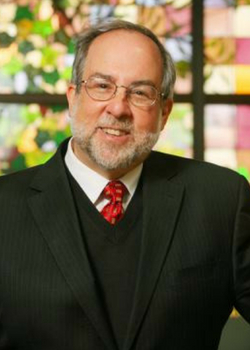When Rabbi Yehuda Loew, the 16th century rabbi of Prague, received word of an imminent pogrom driven by a vicious blood libel, he prayed for divine help. In a dream, he saw ten Hebrew words forming an alphabetical acrostic: "Create a Golem of Clay, Destroy Those Tearing Israel's Heart."
He spent the next seven days fasting and praying, then, at midnight, took his son-in-law and his disciple to the banks of the river Moldau. Out of river clay, they fashioned a giant. Under the creature's tongue, Rabbi Loew placed a slip of paper inscribed with the secret, unutterable name of God. On the creature's forehead, the rabbi wrote, Emet, "Truth." They circled the creature seven times, reciting sacred incantations, and the creature came alive. Rabbi Loew commanded, "Stand," and the creature stood. They dressed him in servant's clothes and brought him home. As three they had come; as four they returned. Thus was the Golem of Prague born.
The Golem lived in the Rabbi's house. Strong as ten men, invulnerable, able to turn himself invisible, he went out each night to fight those who threatened the Jews. Repeatedly, he saved the community from harm. But the Rabbi worried that the Golem's awesome powers would be misused. Despite his warnings, members of the household once sent the Golem to the river to bring water. But they did not know how to stop him. Soon all were in danger of perishing in a flood. Only the Rabbi's timely arrival saved them from drowning.
Fearing a calamity, the rabbi brought the Golem to the synagogue attic, and commanded him to lie among the old tallisim and prayerbooks. The Rabbi removed the slip of paper from the Golem's mouth, and erased the first letter on his forehead, changing Emet, Truth, to Met, Dead. And the Golem turned back into lifeless clay. To this day, the Golem is said to rest and wait in the attic of Prague's ancient synagogue.
In fact, he lives. He lives in Israel. He lives among us here in America.
Jewish discourse is awash in harsh anger. The Right accuses the Left of disloyalty, of treason. The Left charges the Right with moral blindness and senseless chauvinism. Combat flares up, of all places, at the Western Wall. The Wall, which stands as witness that the Temple was destroyed because of sinat chinam, boundless hatred. As the rhetoric rises, one hears the same cry from every side: Enemy! Destroyer! Seamlessly, the accusations drift into accusations of anti-Semitism. The Holocaust is invoked. "What Hitler couldn't accomplish, you will!"
We are an angry people. The horror of the 20th century has left us with a collective case of post-traumatic stress disease. Attacking our own is one symptom of this PTSD. Like the Golem, rage is a defense mechanism designed to protect us. Rage gives us the strength to defeat an enemy. But like the Golem, rage has no discretion. It attacks everything. It doesn't know when to stop. Without an external foe, our rage is displaced. It is directed internally, against our own. It stands behind a banner of Emet, an exclusive hold on the Truth. It speaks in the Name of God. And it will surely drown us.
The ancient priests of Israel, the Kohanim, were forbidden to attend the dead or the dying. A puzzling instruction. We would expect the opposite. When there is a death in the community, the rabbi is among the first we call for help. Why were priests not permitted to attend to the dead? The Ishbitzer Rebbe, Hasidic master of the 19th century, answered: The presence of death brings rage and bitterness. The priest is Oved Hashem, the servant of God, the embodiment of God's love and care. One so charged cannot carry out his calling with a heart full of anger. Rage and bitterness disqualify him. Only one free of anger may lead and teach and serve the Jewish people.
This week, we stand between the two commemorations, remembering the cataclysmic events of the Jewish 20th century, Yom Ha-Shoah and Yom Ha-Atzmaut, remembering the Holocaust and celebrating Israel's birth. Yom Ha-Shoah brings tears as we struggle to grasp how we might remember the Six Million. Yom Ha-Atzmaut brings song as we realize the miracle of our national rebirth and sovereignty. How are we to live between two such disparate moments? How to respond to such emotional gyration? At least this: Not through anger. Not through bitterness. Not through accusation. Not through invective. Not with rage. We must not remember the victims by becoming complicit in our own destruction.
In the imagination of the Talmud, God prays each morning. And what, the Talmud asks, does God pray? "May it be My will that My love may suppress My anger, and that My love may prevail over My [other] attributes, so that I may deal lovingly with My children." So may it be for us.

